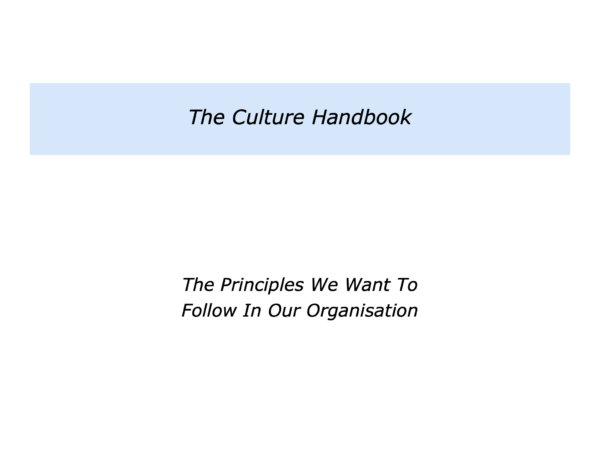
There are many ways to build a principles driven organisation. This section describes an approach that worked effectively during the Covid lockdown when it was difficult to do off-site workshops.
The approach has since been adapted by other work places. It works best in places where people have already discussed the possibility of building a principles driven organisation.
The example described in this section was driven by the leadership team. It also gave other key people a sense of ownership in shaping the organisation’s future. Here is some background to the approach.
The Culture Handbook Approach
This involves the leader and leadership team putting together a Culture Handbook that can be used in the organisation. The handbook describes the principles that people can follow to help the organisation to achieve success.
There are many ways to arrive at such principles. One approach is:
To clarify when people in the organisation have done superb work and delivered success;
To clarify the principles they followed to do superb work and deliver success;
To clarify how they can follow these and other principles – and express these in modern ways – to deliver future success.
There are many ways of communicating these principles to people in an organisation. Before the lockdown one approach was to go through the following steps. It was:
To do workshops with the leadership team to clarify the principles that people could follow to deliver success;
To do workshops with all the employees to communicate the principles and involve them in clarifying how to translate these into action to deliver success;
To follow up by continually publishing success stories that showed how people were following the principles and delivering success.
This approach became more difficult during the lockdown. Bearing this in mind, I used the Culture Handbook approach when a leader asked me to help their organisation to clarify its principles. Let’s call is Organisation A.
Here is a precis of the approach that we arrived at as result of our conversations.
Organisation A – The Background To
Building A Principles Driven Organisation
The organisation had around 80 people spread in locations across the world. This had both advantages and disadvantages.
The advantages were that it hired high quality employees who could do superb work in the different countries. This enabled it to stand out from its competitors. The disadvantages included it being hard to maintain consistency. It was also sometimes challenging to manage such people.
The leader, who was also the founder, had a charismatic personality. At the beginning this was a strength because they inspired people to do fine work. This proved more difficult as the organisation got bigger and people waited for the leader to make decisions.
The leader and the leadership team wanted people in the organisation: a) to align their efforts to following certain principles; b) to deliver consistently high standards; c) to use their strengths to deliver success.
The leader and I explored how to make this happen. He eventually decided it would be useful for the leadership team to take the following steps:
To build an organisation that was principles driven rather than personality driven;
To focus on managing the principles rather than just managing the people;
To also encourage people to use their strengths to translate the principles into action and deliver ongoing success.
After discussions with the leader and other key people, we embarked on taking the following steps. (Other organisations that I worked with later followed elements of this approach in their own ways.)
The Leader Starts By Putting Together A
Provisional Version Of A Culture Handbook
The leader had strong views about the principles people could follow to help the organisation succeed. Whilst it would be important to involve other people, it made sense to begin by getting him to clarify these views.
Bearing this in mind, I invited him to describe what he saw as the organisation’s purpose, principles and picture of success. We could then invite others to add to this framework.
The following section provides a summary of his thoughts. (I have described these in generic terms rather than the detailed descriptions he gave.) Here are the main themes.
Purpose
The purpose of our organisation – the
specific thing we want to do – is the following.
We want:
To use our strengths to do superb work that helps all our stakeholders to achieve success.
Principles
We want to encourage our people to
pursue the following principles in our work:
To Be Professional
To have a positive mindset and behave in a professional way towards both internal and external customers.
To Take Ownership And Focus On Outcomes
To take ownership for doing things and keep focusing on the outcomes to achieve.
To Help Our Customers To Succeed
To provide great service and pass on knowledge in ways that help our customers to succeed.
To Stay Healthy And Keep Developing
To maintain our wellbeing and continue to keep developing as people and as professionals
The Picture Of Success
The specific goals we want to achieve by … are:
To achieve £… in terms of profit.
To achieve a rating of … in terms of customer satisfaction.
To achieve a rating of … in terms of employee satisfaction.
The leader and I had three virtual sessions which involved crafting these themes to his satisfaction. He also shared some of his early thoughts with three people close to him in the leadership team. We then moved on to the next stage.
The Leader Involves The Wider Leadership
Team In Adding To The Cultural Handbook
The leader invited the wider leadership team to add their ideas to the handbook. This involved ten people who had senior roles.
He began by sending out the following email people. This was followed by having a virtual workshop conducted by himself and his two closest colleagues. Here is the email he sent to people.
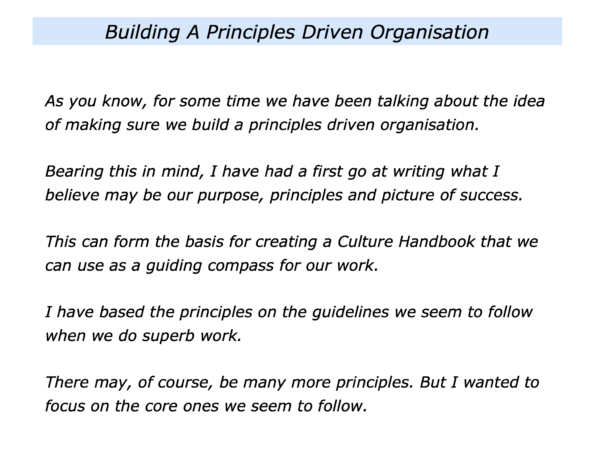
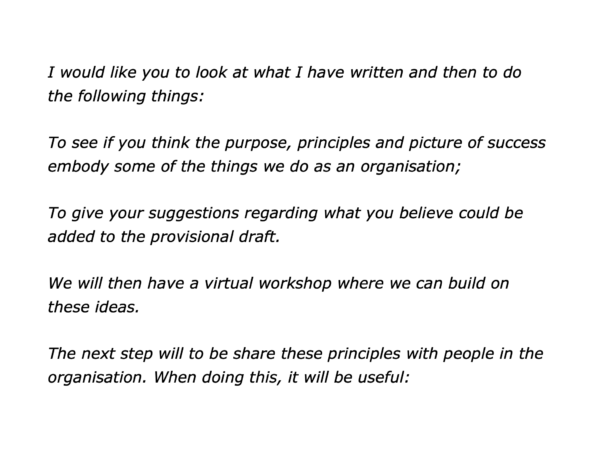
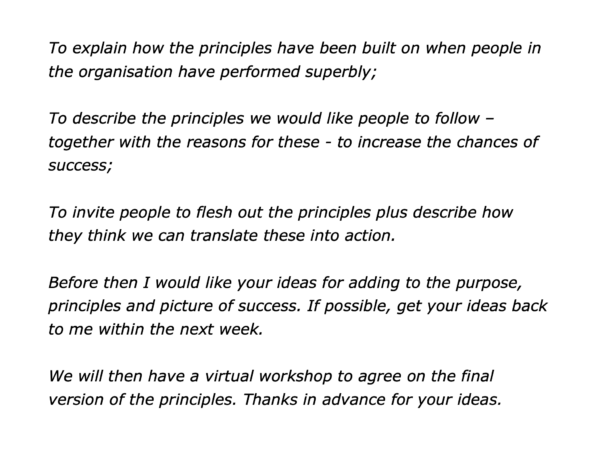
The wider leadership team members responded with their ideas. Many of these mirrored the principles outlined by the leader – though there were some slight differences on wording.
The principle that created the most debate was that around people staying healthy. One person responded to this in the following way.
“If we are serious about people’s wellbeing, it will be important to study organisations where they have made this work successfully.
“We rely on many people who are dutiful in carrying out their work. Sometimes they pay a price for being so conscientious.
“We may need to find ways that enable them to work in smart ways whilst also taking care of the wellbeing.”
The wider leadership team workshop proved successful. After a short introduction, each person gave their views about the principles.
They were in broad agreement about the key themes, though some wanted to go into more detail. The leader suggested that this could be done in small groups.
Bearing this in mind, people formed four groups. Each of these focused on one of the principles. They then aimed:
To give concrete examples of when people had followed these principles successfully in the past;
To give concrete examples of how people could follow these principles in the future;
To give concrete examples of the support people would need to be able to follow the principles successfully.
Each sub-group presented their ideas back to the whole group. After some discussion, the leader said they would work with two other people to complete the next draft of the Culture Handbook.
The wider leadership team then explored how to present the principles to everybody in the company. This would take the form of an All-Hands Meeting being followed up by regional sessions in each of the locations.
Originally the leader saw it as his role to introduce the session and take people through the principles. This changed at the end of the wider leadership team session.
The sub-groups suggested they each take responsibility for introducing the specific principle they had worked on. Whilst the leader could introduce the session, it would help to show how the leadership team were supporting each of the principles.
The leader liked this idea. He also suggested that, if appropriate, I could offer people a framework they could use when introducing the principles to their people. This led to doing some work with each of the sub-groups.
We focused on how we could bring the principles to life in a way that resonated with people. The aim would be that, after presenting the principles, people in the organisation would be saying things like:
“This is us. We recognise ourselves and we want to follow these principles.
“We also believe the organisation is serious about supporting us in following these principles to achieve success.”
The wider leadership team had another virtual meeting where they practiced presenting the principles to their people. They were then ready to move on to the next stage.
The Wider Leadership Team Introduce The
Principles To People Across The Whole Organisation
The wider leadership team did this in the following stages. The leader kicked off the process by writing an email to everybody in the organisation.
This mirrored several of the themes he outlined in his original note to the wider leadership team. Here is a summary of what he wrote.
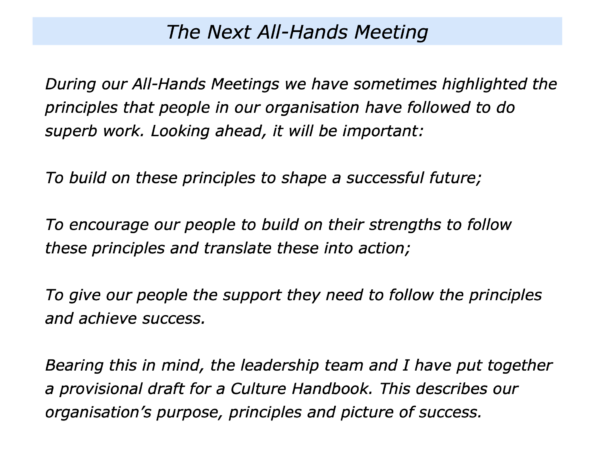
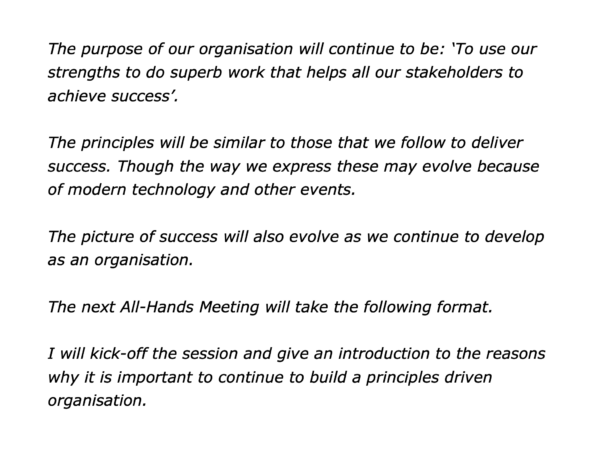
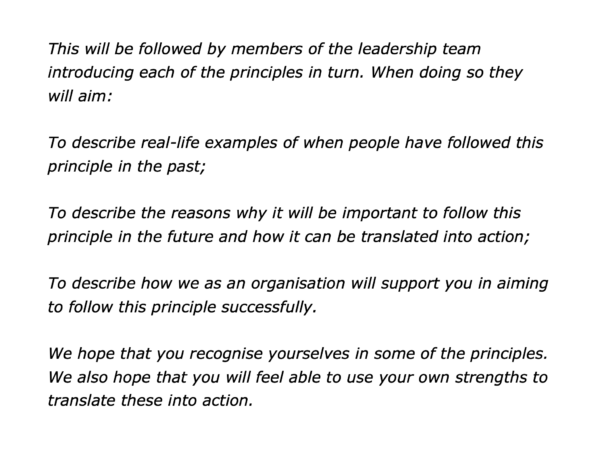
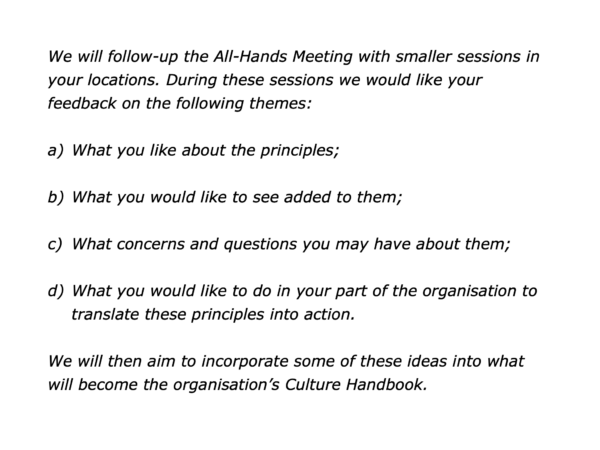
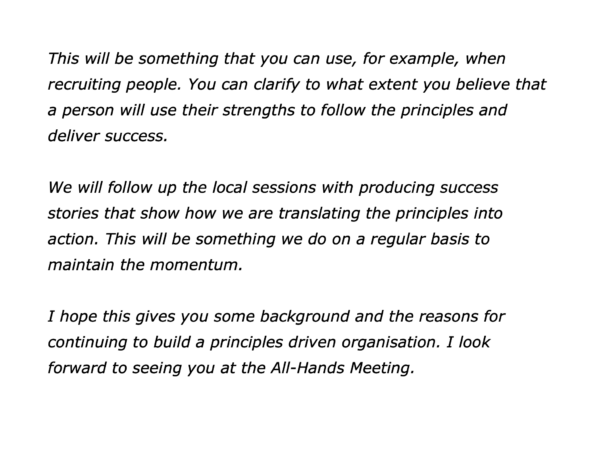
The All-Hands Meeting went well. Like many virtual meetings it had its limitations, but most people enjoyed the session.
The leader started by referring to the organisation’s purpose and gave examples of when people had helped both customers and colleagues. He also referred to the organisation’s picture of success.
The leader emphasised, however, that it was important to follow certain principles in order to achieve sustainable success. He then handed over to members of the leadership team who introduced each of the principles to the wider organisation.
The leaders brought the principles to life by giving examples of when people had translated these into action. This was accompanied by photographs and other illustrations of the people.
During the session there were some written comments from the wider audience. These were mostly complementary or humorous. There were also questions about the extent to which the organisation was serious about following the principles.
The All-Hands Meeting was followed-up by local sessions. As outlined in the email from the leader, this focused on certain themes
People were encouraged to describe: the things they liked about the principles; the things they would like to see added; the concerns and questions they had; the specific things they could do to translate the principles into action.
These sessions were led by members of the wider leadership team. Before conducting them, however, they were given tips. It would be important:
To create a positive environment in which people were encouraged to share their ideas;
To recognise that people would demonstrate their normal personalities – some would be positive, some would be positive/neutral, some may not be positive;
To, if any negative comments emerged, invite people to describe the positive things they would like to see happen instead.
The local sessions produced many ideas that were fed back to the leadership team. Some were then incorporated into the final version of the Culture Handbook. This led to the next stage in the process.
The Organisation Publishes Success Stories
That Highlight People Following The
Principles Outlined In The Cultural Handbook
The leadership team were pleased by the response from most people in the organisation. They then took several steps to increase the chances of success.
The leader hired a writer to produce the Culture Handbook that captured the essence of the organisation. A version of this was given to people who joined the organisation.
The leader appointed a Mission Holder who ensured the organisation kept publishing success stories. These highlighted how people had translated the principles into action.
The leadership team members started every All-Hands Meeting by reminding people of the organisation’s purpose and picture of success. They also gave examples of people following the principles.
Since the end of lockdown the organisation had had several off-sites. These have included customers sharing stories about how the organisation has helped them to reach the goals. This has encouraged people to continue to follow the principles and achieve success.
The Culture Handbook approach is one that can be used as a Trojan Horse for helping people and organisations to develop. Here is the framework for a version that can be given to new joiners. You will, of course, have your own approach to building a principles driven organisation.
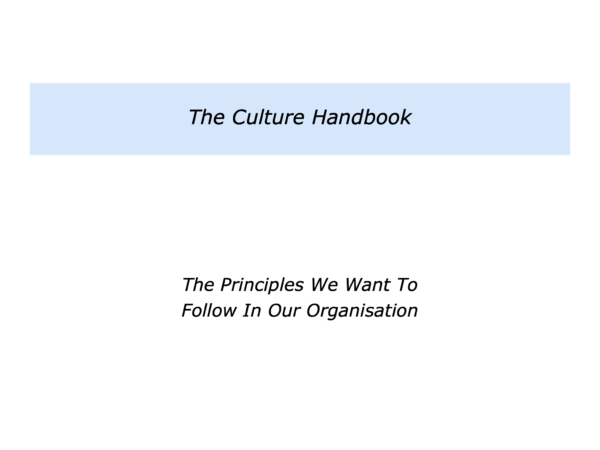
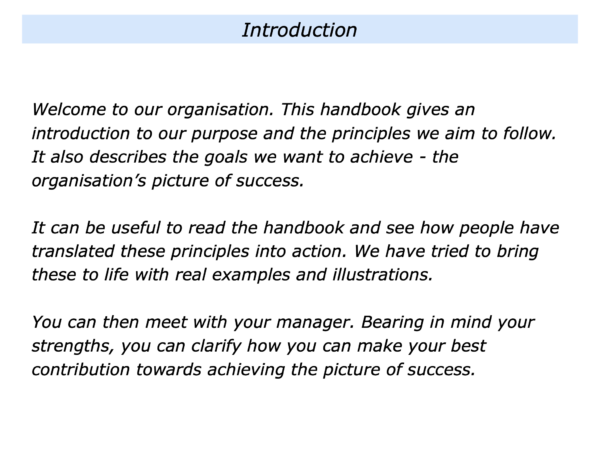
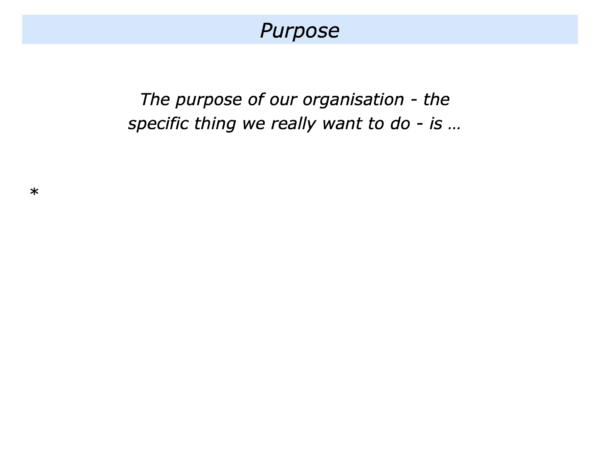
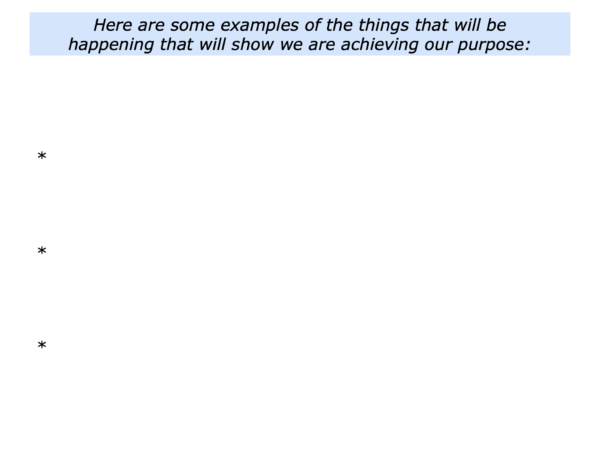
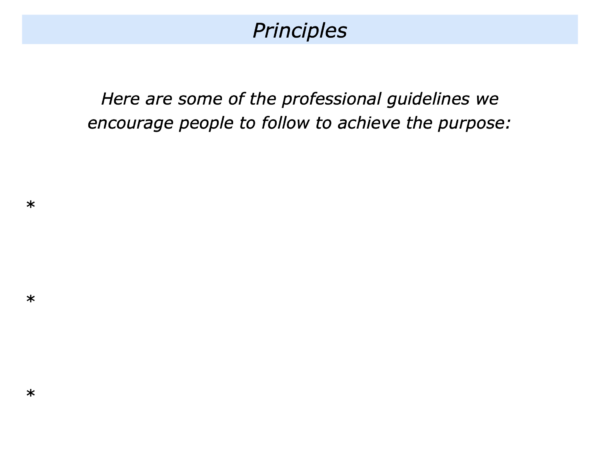
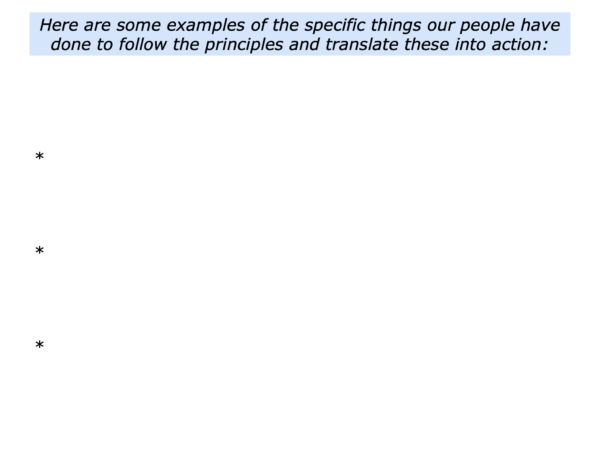
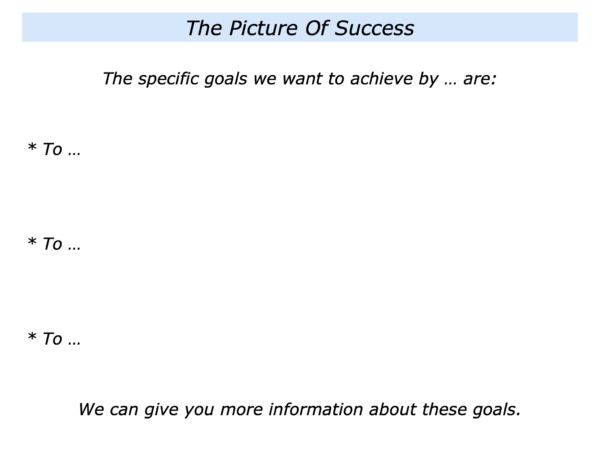
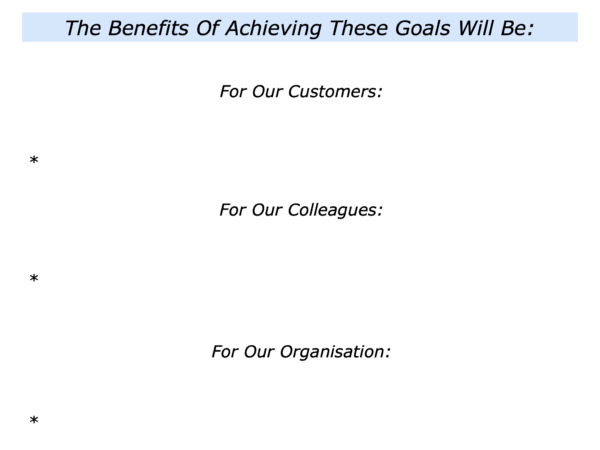
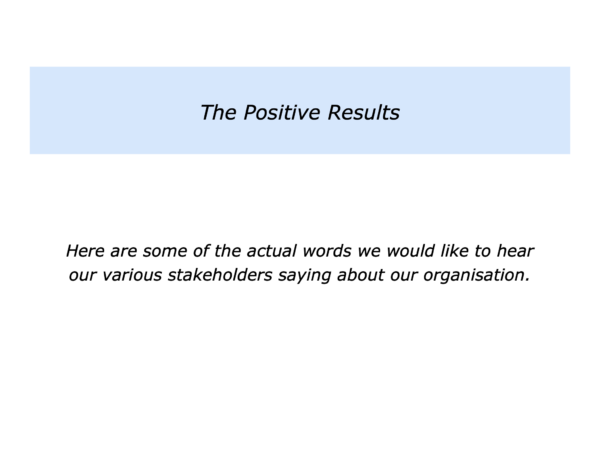
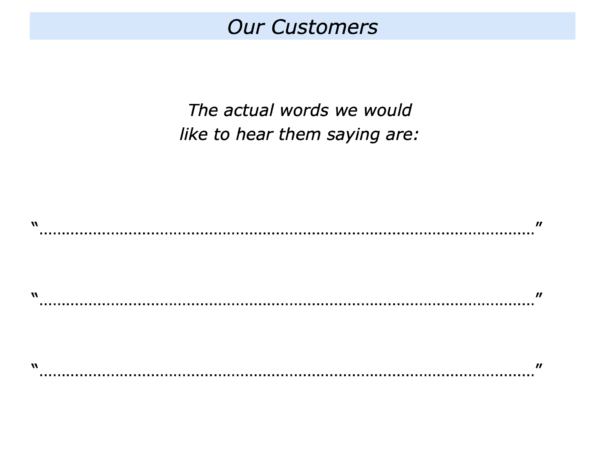
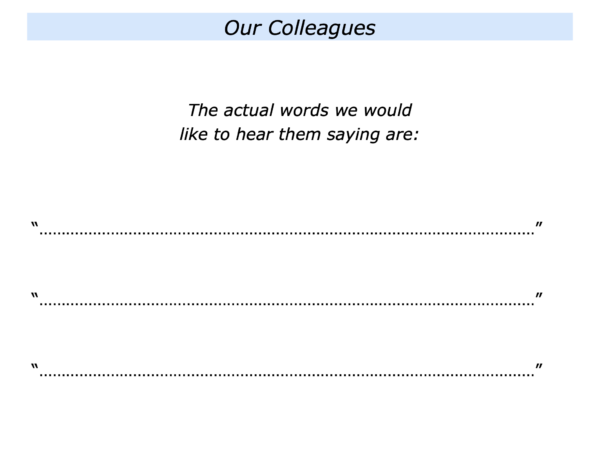
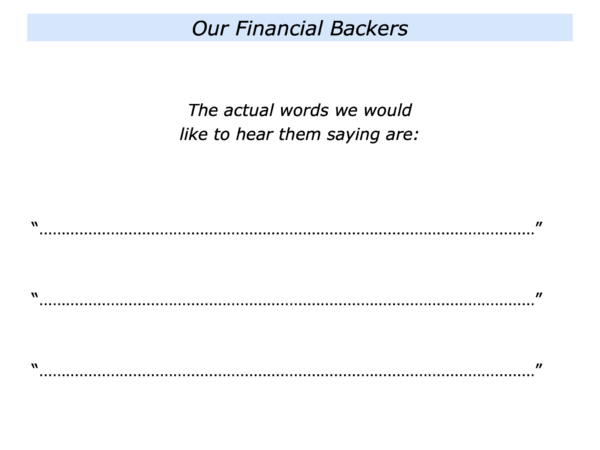
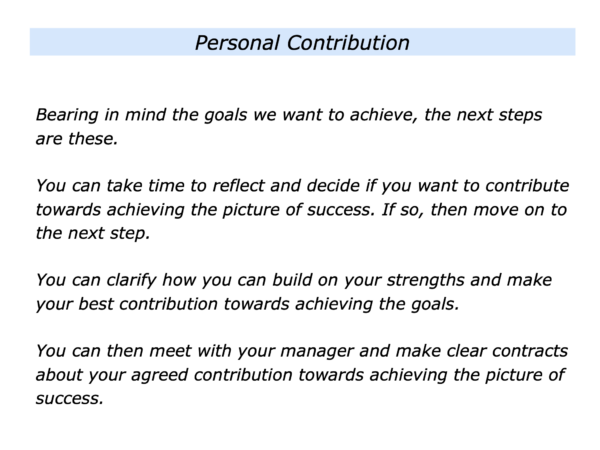






Leave a Reply